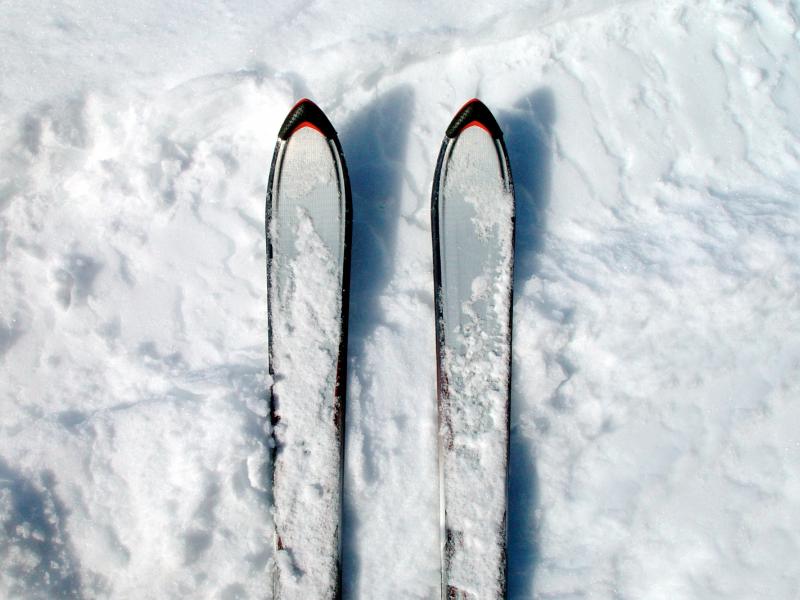How Long Do Skis Last? And When to Replace Them
After throwing down some coins on new skis, the last thing you want to think about is replacing them. But the reality is that skis wear down and ultimately affect your performance and become a safety hazard. So if you've gone a few seasons with your skis, you should know how long they'll last.
Most skis last between 100-150 days of use, which typically averages 5 - 8 years before they need to be replaced. Ultimately, the lifespan of your skis depends on factors like ski style, maintenance routine, the type of terrain you ski on, how frequently they’re used, and their quality.
This article will cover everything you should know about the lifespan of skis and how to know when it’s time to replace them. With proper maintenance, you can make sure they stay in peak condition for a long time!
What Affects How Long Skis Last?
While most skis last between 5-8 years before they need to be replaced, this timeline increases or decreases based on 5 main factors:
- Frequency of use
- Maintenance
- Storage routines
- Style of skiing
- Skiing terrain
Some skis will last longer or shorter than the average, depending on how they’re used and cared for. Here's what you need to know about each contributing factor.
Factor #1 - Frequency of Use
Just like with any piece of equipment, the more you use your skis, the faster they'll wear out.
Those who ski frequently will need to replace their equipment more often than those who only go once or twice a year. The lifespan of skis depends on how often they're used rather than how old they are. Generally, skis should last 100 - 150 days of use.
The average skier skis around 12 - 15 times a year. So if you’re skiing more than that, your skis will likely need to be replaced more regularly than 8 years.
Factor #2 - Proper Maintenance
Proper maintenance is vital for increasing your ski’s lifespan. Skis that are properly stored and cared for will last longer than ones that are ignored after every use. If you want your skis to last for a long time, follow the tips below.
Wax and Sharpen Your Skis Regularly
Waxing your skis is essential because it keeps the base and edges from becoming dry. It also helps to keep your skis smooth. Smooth skis can easily repel water so they glide effectively.
Sharpening your skis is equally important when it comes to performance and maintenance. Not only do sharper edges improve your control while skiing, but this also helps to remove any chips that develop along the edges.
Repair Nicks
It’s completely normal to get nicks and chips in your skis. And the more frequently you ski, the more nicks you’ll get. This doesn’t mean your skis need to be replaced as soon as they’re damaged. You can easily repair surface-level damage with epoxy. Just make sure your skis are completely dry before doing any repairs.
If you fail to repair nicks regularly, your skis will wear out much faster, and you’ll need to replace them sooner.
Factor #3 - Store Skis in a Proper Location
If your skis are left lying around, they’re much more likely to deteriorate. The optimal way to store skis is in a dry ski bag. If you don’t have one, it’s perfectly safe to store them in a dry, closed area.
Storing them in the garage, basement, or attic is not the best idea. These environments tend to be damp and prone to temperature changes. Try keeping them in a closet or tucking them away in your room.
Dry Your Skis Off
Skis that are not dried properly after each use may start corroding on the edges. This will make the edges more susceptible to damage and ultimately shorten the lifespan of your skis.
The worst thing you can do in terms of storage is put your wet skis into a ski bag. They’ll start to rust in no time.
Factor #4 - Skiing Style
This one may seem obvious, but it makes a huge difference - so we’re mentioning it anyway. If you’re more of an “aggressive” skier, your skis will inevitably have a shorter lifespan. And if you ski more conservatively, your skis will last longer.
Factor #5 - Type of Skiing Terrain
This brings us to the last factor - skiing terrain. Bumpier, more challenging routes are bound to wear out your skis. So if you’re skiing on more rugged trails, your skis will have a shorter lifespan.
If you know you’re going to ski on rougher terrain, investing in better-quality skis may be worthwhile. This will undoubtedly improve your ski’s lifetime and give you better control.
When Is It Time to Replace Your Skis?
It’s recommended to replace your skis every 5-10 years, but there are two clear signs that it's time to replace your skis, even if they haven't made it to their 5-year or 10-year anniversary:
- A sharp decrease in ski performance
- Your skis have noticeable damage that cannot be easily repaired
You can also replace them if they’re not performing well, if they have obvious damage, or if they aren’t right for the type of skiing you want to do.
Unfortunately, no matter how careful you are and how well you maintain your skis, they all have an expiration date. Some telltale signs will let you know that it’s time to order a new pair.
1. They’re Not Performing Well
The performance of your skis largely depends on your level of expertise and your skiing preference. If you enjoy challenging routes, you’ll need to have more control over your turns to stay on track and avoid hazards.
If your ski performance is slipping at no fault of your own, you’ll also be at risk of falling and getting hurt - and we all know that ski-induced injuries can be intense. Regardless of your level of experience, you’ll be able to tell when your skis become less responsive.
If you’re an expert, your performance and level of control will matter a lot more. If this is the case, you’d probably want to replace your skis more frequently than someone who just does skiing for fun.
2. They Have Obvious Damage
When there are signs of undeniable damage, you should probably retire those skis and start shopping for a new set. Some tell-tale signs of damage include:
- The steel edges are badly nicked, cracked, or deformed
- The top sheet is peeling or torn
- The bases are very worn or thinned out
- The camber is flattened
2 Reasons Why Skis Should Be Replaced Every Ten Years
Apart from the “damage” aspect, there are other important reasons why it may be a good idea to replace your skis no more than every ten years. Even if they’re still in decent shape, there are sometimes other factors that may prompt you to buy a new pair. Here are two of the primary reasons to swap out your skis at least once a decade.
1. New Designs Come Out Every 5 Years
If you’re a good skier and enjoy improving your skills, you may be interested in the latest models and updates. Newer skis will give you more control, and better handling, and allow you to glide effortlessly through the snow.
Plus, there are often new shapes, decorations, and styles that suit your preferences.
2. Different Skis for Different Terrains
Skis are designed to handle different terrains. Therefore, depending on your preferred terrain, you may want to invest in several different sets. While there are generally three main types of skiing, there are many offshoots to each. But each style requires a different type of ski.
Here are some guidelines:
- Carving skis are a good option for skiing on groomed slopes.
- Shorter, narrow, flexible skis are ideal for bumpier terrains and moguls.
- Powder skis are longer and are better suited for deeper snow conditions.
- Park skis are great for tricks and jumps.
Some people get different skis to suit the different terrain types they’ll encounter.
So, Should I Keep My Skis or Replace Them?
While most experts suggest replacing your skis every 5 - 10 years, this is just a guideline. It ultimately depends on your needs and the condition of your skis.
For example, if your skis are 15 years old but are still in good shape, then there’s no need to replace them just because of their age. But if you notice a considerable dip in performance, handling, and so on, that’s your cue to get an upgrade.
Finally, it’s always important to ensure you invest in high-quality skis and practice proper maintenance if you want to get the most out of them. You can easily increase the lifespan of your equipment if you take good care of it.



